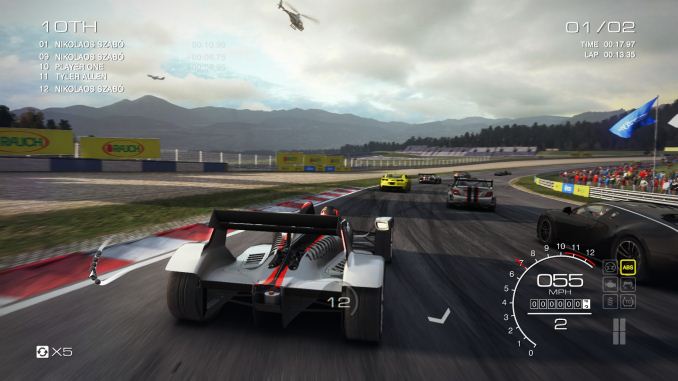The Asus Prime Z270-A & GIGABYTE Z270X-Ultra Gaming Motherboard Review
by E. Fylladitakis on July 18, 2017 10:45 AM ESTGaming Performance
The issue of FCLK settings might play a big role here. At launch, the default setting for the communication buffer between the CPU and PCIe stack was 800 MHz, even though Intel suggested 1000 MHz, but this was because of firmware limitations from Intel. Since then, there is firmware to enable 1000 MHz, and most motherboard manufacturers have this - but it is unclear if the motherboard will default to 1000 MHz and it might vary from BIOS version to BIOS version. As we test at default settings, our numbers are only ever snapshots in time, but it leads to some interesting differences in discrete GPU performance.
(A side note from Ian: This is one of E. Fylladitakis first motherboard reviews and we supplied him with a single GPU to get started. This may change in the future. But ultimately the gaming tests have been more of a checkbox for abnormal behaviour, as with the CPU tests, to make sure nothing fishy is going on.)
Total War: Attila
The Total War franchise moves on to Attila, another The Creative Assembly development, and is a stand-alone strategy title set in 395AD where the main storyline lets the gamer take control of the leader of the Huns in order to conquer parts of the world. Graphically the game can render hundreds/thousands of units on screen at once, all with their individual actions and can put some of the big cards to task.
For low-end graphics, we test at 720p with performance settings, recording the average frame rate. With mid and high range graphics, we test at 1080p with the quality setting. In both circumstances, unlimited video memory is enabled and the in-game scripted benchmark is used.

GRID: Autosport
No graphics tests are complete without some input from Codemasters and the EGO engine, which means for this round of testing we point towards GRID: Autosport, the next iteration in the GRID and racing genre. As with our previous racing testing, each update to the engine aims to add in effects, reflections, detail, and realism, with Codemasters making ‘authenticity’ a main focal point for this version.
GRID’s benchmark mode is very flexible and, as a result, we created a test race using a shortened version of the Red Bull Ring with twelve cars doing two laps. The car is focus starts last and is quite fast, but usually finishes second or third. For low-end graphics, we test at 1080p medium settings, whereas mid and high-end graphics get the full 1080p maximum. Both the average and minimum frame rates are recorded.














34 Comments
View All Comments
A5 - Tuesday, July 18, 2017 - link
A good comparison review of products that people will actually buy instead of the $500 monstrosities we normally see. Thanks.theuglyman0war - Friday, July 21, 2017 - link
The only reason I invested in flagship enthusiast bait was to bet on the components being built to last and stand up to harsh worst case scenarios.Considering they were built to handle punishment under ln2 extremes.
But they usually went on sale fairly quickly after the initial release. ( the rampage extreme III I am still sitting on I bought for well under $400 in about 3 months after release )
I assume those days are over?
Which is a shame considering the punishing volt experiementation and water accidents I have had...
Hedging my bets on the expensive caps and mosfets have seemingly bought me longevity to wait out this incremental expensive hell!
In the interim on client builds...
I been getting the mil spec bait instead.
A comparison between the mil spec branded stuff between gigabyte and asus would be interesting as well as an honest exploration whether as much is actually of a grade that might guarantee longevity/abuse? Or manufacturer ad nauseam abuse that offers no value compared to server grade branded stuff? ( asus prime ).
Is there a mil spec ansi standard that is legally meaningful?
The relative cheap price compared to the gaming flagship bait seems reasonable.
But I am not even sure about server grade claims? Compared to say...
The expense of Super Micro?
I close my eyes n just buy the cheapest "tuf" branded boards n cross my fingers.
OddFriendship8989 - Tuesday, July 18, 2017 - link
I can't comment about these two boards specifically, but I've used the Gaming K7 and Maximus IX Hero, and while I feel Gigabyte tends to be more generous in features, as someone who overclocks, I really need the Adaptive voltage setting that's missing from GIgabyte boards.RiZad - Tuesday, July 18, 2017 - link
"The default boot time of both the Asus Prime Z270-A and the GIGABYTE Z270X-Ultra Gaming is very good, with 12.6 seconds for the former and 13.4 seconds for the latter" something is wrong with the graph for that because thats not at all what is shown. it seems to have the default and stripped reversed. the other 2 points of comparison show default on top, stripped under.jbrl - Tuesday, July 18, 2017 - link
Would have really liked to see a comparison to a 170 board with the updated bios. Otherwise, why should I drop a few hundred extra on a new board?A5 - Tuesday, July 18, 2017 - link
If you're already on a Z170 board there is no reason to upgrade.jbrl - Tuesday, July 18, 2017 - link
Thanks, that is what I was thinking. I guess they can't put that in the review because asus will stop sending them samples.shabby - Tuesday, July 18, 2017 - link
Ultra gaming tactical pro sli ftw edition... this is getting a bit absurd.MajGenRelativity - Tuesday, July 18, 2017 - link
While there is certainly a proliferation of longer names, I feel these motherboard names are not excessively long. Sure, they could be shorter, but I feel that it doesn't give off an "Ultra gaming tactical pro sli ftw thor odin lightning edition" vibeBullwinkle J Moose - Tuesday, July 18, 2017 - link
Boot Times look Horrible!I wish Intel would streamline their chipset for speed
I remember how a 1st gen ATOM motherboard with IDE/serial and parallel ports and 2GB Max Ram booted several seconds faster than the 2nd Gen ATOM with 4GB Ram due to the chipset features
Faster CPU's require faster chipsets streamlined for speed freaks!
A stock install of Windows XP on a sammy 840 or 850 Pro boots in 3 seconds on a 35 Watt dualcore Sandy Bridge
A stock install of Windows 10 takes alsmost 10 seconds longer to boot on the same system
disregarding the O.S., chipset features and BIOS should advance with the CPU to match the boot speeds of ancient systems
Why is no-one questioning what is actually limiting the boot speeds on newer systems?
I don't think you can "really" fix this with a different brand of motherboard
We can see that some brands do better than others, but I would think that a sammy 960 Pro booting Win 10 on a new 4+Ghz quadcore CPU could (or should) beat an ancient dualcore system at half the clockspeed in boot times
After all, Win 7 was optimized and advertised as booting faster than XP
Win 8 was optimized and advertised as being faster than Win 7
and Windows Spyware Platform 10 was supposed to be faster than Windows 8.1
What gives?
This is DEFINITELY not fake news!